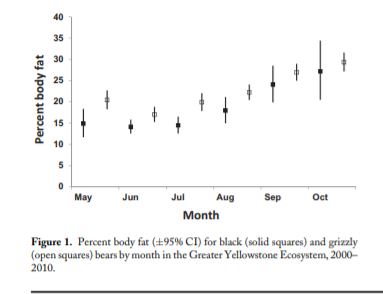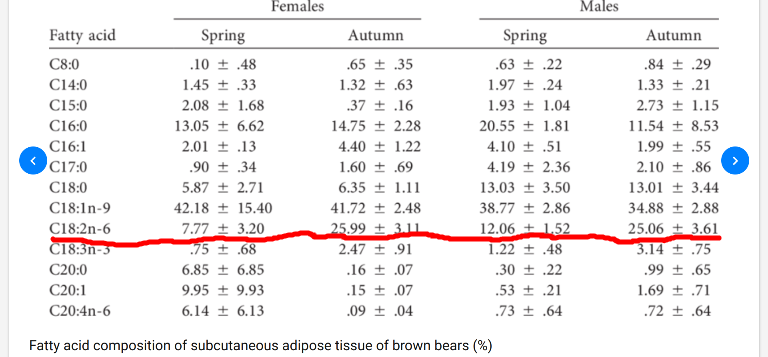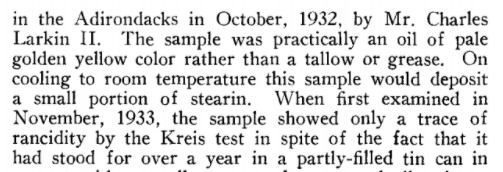Introduction
This is a followup to my post Native Americans Removed Acorn Oil and Replaced It With Bear Fat. It also carries on the theme of adaptive thermogensis, which I introduced in This is Your Body Temperature on Vegetable Oil and continued in The Body Fat Saturation Of Starch Eaters; Linoleic Acid Dysregulates SCD1.
In this article I argue that Native Americans sacrificed fat yield to harvest bear grease in a season where the polyunsaturated fat(PUFA) content of the fat would have been the lowest. This had some practical advantages, such as sleepy bears, less tendency towards rancidity and better storagibility, but I believe the example of removing acorn oil and replacing it with lowish-PUFA bear fat suggests that they understood the metabolic advantages of avoiding PUFA in a cold region.
Bear Grease Was A Dietary Staple
Bears were the pigs of North America – omnivores who fattened on berries, fish, honey, ants and mast (acorns and nuts). Native Americans would even sometimes capture baby cubs and fatten them on cornmeal for as long as two years in wooden pens!1 Since they are hibernators, bears can store a tremendous amount of body fat and bear fat was the chief fat used in many Native American diets. Consider this passage from James Smith, an Englishman who was taken hostage by Native Americans and lived with them for five years.2

And Native Americans were sophisticated in their understanding and use of bear grease. They would add antioxidants to the fat to prevent rancidity.3

Of course the bears are the fattest in September and October, when mast crops are plentiful. They have the least fat in late winter through summer.4 So they hunted them in the fall, right?

Bear was mostly Hunted Late Winter Through July
Harriet V. Kuhnlein and Murray M. Humphries have done a great job of collecting references having to do with Native American bear hunting at Traditional Animal Foods of Indigenous Peoples of Northern America.1 Although bears were hunted year around, it seems they were overwhelmingly hunted in late winter or spring – when they were leanest, especially in the frigid North!
Springtime hunting was common for the Naskapi, when they hoped to encounter “the great beast” asleep in his “winter bed”. … Micmac (Mi’kmaq) orchestrated the “great hunt” for game, including bear, from February to mid-March. Inuit deemed the months of March and April ideal for hunting bear, … Southern Okanagan also sought bear in the hills during these months, when bears first came out of winter dens and were still fat; they continued the hunt into fall . Eyak usually sought bear in early spring or summer; the Montagnais also hunted bear in early spring or summer between Tadoussac and Three-Rivers .
Chipewyan, Yellowknife (Dene), Slave (Sahtu), Dogrib, Hare (Sahtu), Nahani (Dene) and Kutchin killed bear mainly during their winter hibernation when the flesh was thought to taste better.
In summer, bear was described as rather easy to kill . During berry season, which, depending on the region, usually spanned late summer and into fall, Upper Liard Kaska, Tselona Kaska, Fort Nelson Slave, Mistissini Cree and Waswanipi Cree lay traps and killed the animal in berry patches where it was known to feast on ripening fruit. … James Bay Cree sought bear June and July … Potawatomi designated January as “big bear month” … February was known as “baby bear month” … Northern Iroquoian hunting groups “went to the woods to hunt meat”; at mid-winter, they abandoned the village and walked several days into the forest.
Harriet V. Kuhnlein and Murray M. Humphries, Traditional Animal Foods of Indigenous Peoples of Northern America
Although it certainly would have been a luxury to hunt sleepy and confused bear just emerging from their winter slumber, Native Americans were ingenious hunters and had many ways of killing bear, so they certainly could have hunted bear in October at the peak of their fatness. Consider these techniques1:
Bears were killed using deadfalls, where a strategically balanced, heavy log or rock was triggered by the animal, that then fell on it, pinning or killing it instantly … Carrier relied principally on snares made of twisted babiche . They sometimes erected a wooden platform over which a collapsible roof was built and weighted with rocks.
HARRIET V. KUHNLEIN AND MURRAY M. HUMPHRIES, TRADITIONAL ANIMAL FOODS OF INDIGENOUS PEOPLES OF NORTHERN AMERICA
So then why late winter? “Some cultures sought out hibernating bears in their dens because bear flesh was often considered best during winter or at the end of hibernation.1“
PUFA Content of Bear Meat Peaks in the Fall And Is Least In The Spring
If you’ve been following this blog, you will be familiar with the concept that having saturated body fat leads you to produce a lot of mitochondrial Reactive Oxygen Species (ROS), which forces you to do mitochondrial uncoupling which increases your metabolic rate and keeps your body temperature high. Your metabolism becomes “inefficient” since you are simply burning off calories as heat rather than storing the energy for later use.
If you’re a bear you want the exact opposite of that scenario. You need to store enough fat to get through a 5 month hibernation. While hibernating, you need to drop your body temperature and lower your metabolic rate to conserve energy. You certainly don’t want an inefficient metabolism.
Therefore you would expect a bear to have highly unsaturated fat going into hibernation and you might even expect the bear to preferentially burn the unsaturated fats during hibernation to help suppress ROS generation, body temperature and metabolic rate. Bears graze on “mast” in the fall – acorns and other nuts that fall to the forest floor. So they have a ready source of PUFA in their diet in the fall. So you might expect a bear to accumulate PUFA in the fall to help it gain weight then burn that PUFA over the course of winter. This might even lead to “better meat quality”.
There is frustratingly little data about the American black bear body fat composition or how it changes seasonally, but I suspect this data from a Croatian bear would be mirrored in the US.5 Croation bears also fatten on acorns. I’ve underlined in red the line that represents the polyunsaturated fat linoleic acid in bear tissue. It decreases by 50% over the winter!

And consider this description of bear oil collected in the Adirondacks of upstate New York in October of 1932.3

The bear oil was a liquid and slightly rancid. Native Americans stored their bear grease in bark or deerskin containers. Consider this description, “Bark trays were strategically positioned to catch the rendered fat, which was stored in deerskin bags. Fort Nelson Slave stored the fat in bark containers to solidify and consumed it with ‘great relish'”.1 The phrase “to solidify” suggests that the fat collected was not the oily fat described above. Also, solidified fat would have been much easier to store and transport in deerskin or birch-bark containers!
Conclusion
Let’s add it all up. Native Americans frequently waited to hunt bear – their main source of fat – until the animals had lost a significant amount of body fat. The reason given was that “bear flesh was often considered best during winter or at the end of hibernation”. The liquid fat collected from fat bear in the fall would have been difficult to store and prone to rancidity. So they accepted a lower yield for a fat that was presumably lower in polyunsaturated fats.
Did the Native Americans in the North who would have put a high premium on the ability to do adaptive thermogenesis while riding out a frigid winter feasting on maple sugar, venison jerky and bear grease also know that bear grease that was too high in polyunsaturates would effect their ability to stay warm? I suspect they did. Why else would they have replaced acorn oil with bear grease? Is it it interesting how similar the linoleic acid content of acorn oil and fall bear grease is?6

- 1.Kuhnlein H, Humphries M. Bears. Traditional Animal Foods of Indigenous Peoples of Northern America. http://traditionalanimalfoods.org/mammals/bears/
- 2.Smith J. An Account of Remarkable Occurences During Captivity With The Indians. Grigg; 1831.
- 3.Hoyt LF. Bear grease. Oil Soap. Published online May 1934:85-86. doi:10.1007/bf02640869
- 4.Schwartz CC, Fortin JK, Teisberg JE, et al. Body and diet composition of sympatric black and grizzly bears in the Greater Yellowstone Ecosystem. Jour Wild Mgmt. Published online November 5, 2013:68-78. doi:10.1002/jwmg.633
- 5.Vranković L, Delaš I, Reljić S, et al. The Lipid Composition of Subcutaneous Adipose Tissue of Brown Bears (Ursus arctos) in Croatia. Physiological and Biochemical Zoology. Published online May 2017:399-406. doi:10.1086/690913
- 6.Kaplan M, Kokten K, Bengu AS, Kardes YM, Das A, Sekerci AD. Fatty Acid Composition of Different Quercus Species. Chem Nat Compd. Published online March 2019:313-315. doi:10.1007/s10600-019-02675-x

How can you write this without citing Ray Peat? It follows that we should eat carbs and even avoid omega-3s to keep our metabolic rate high. After all, carbs are often used/stored as sat fat. Are you aware that Apache leader geronimo & co. knew thats fish had different fats and avoided them? What about yellow fat disease and the formation of lipofuscin — or liver spots on the skin? These are PUGA+ iron+ estrogen that have caked in the liposomes of our cells and inhibit autophagy (another reason why fasting is a bad idea). I’ve also seen a study where shortest lifepan across organism was found in organisms with the MOST unsaturated tissues. (Sincerely, @antibiohacker on twitter)
Honestly I’ve yet to read any of Ray Peat’s work, although I should! I know we have a lot of similar ideas, we’ve just gotten there form different angles. It’s interesting to know that Ray Peat also studied Native American dietary choices.
Brad
When you say “another reason why fasting is a bad idea” Can you expand on this? what kind of fasting? I currently do OMAD 5x a week and then whatever on weekends. Generally not hungry in mornings though. Thanks
Ray Peat is great, you’d get a kick out of him. Another interesting theory is from Grant Genereux regarding vitamin A . His use of epidemiology reminds me of you. The theory also offers up a possible mechanism for smoking having positive health effects. Here is a good post below:
https://ggenereux.blog/2015/02/12/eca/
Looks interesting. I’ll read it tonight. I HAVE listened to one Ray Peat podcast, so I know a little…
Hi, I did suspect that bears are not gaining fat during the spring, and Schwarz confirms that. The bears have to wait for the miracle of Pufas and carbs (berries etc), don’t they? Interestingly, they suspected that false truffels were consumed by female bears…
Likely-surely the taste and preservability affected Indians preferences. They also had pemmican (bison jerky disinfected and packaged in hot bison “ghee”), the “shelflife” of which was years at best.
JR
https://www.amazon.com/100-Grass-Beef-Tallow-pound/dp/B01B8LGEWM
Pure Rendered Premium Tallow from the kidney fat (suet) of 100% Grass Fed Beef
Check it out- has a nutty buttery smell- amazing.
Brad – there is a theme that seems to carry throughout all of your posts and comments. You clearly state that you eat one meal a day or in a short eating window. Could that be the real magic? To my understanding a person can eat the worst possible SAD diet just once a day and drop to or remain at a normal weight.
My wife and I started your way of eating a couple of days ago and are excited to see how it works out. In that short time we have consumed about 1.5 pounds of butter and virtually no PUFAs. We also have ordered a couple of your products to help along the way.
Any chance you have data that shows your way of eating isn’t dependent on only eating one meal a day? For the record we eat between 2:00 and 5:00 p.m.
Also, was looking at your pork offerings – any change you plan to offer Pork Belly as a stand alone product down the road?
Steve
I’m actually starting a dietary trial which ISN’T in a short eating window for this exact reason! One of the reasons I like Ssmaller eating windows is my hunch that a very large meal stimulates metabolic rate and I don’t want to have two large meals a day. Have you seen David’s Story?
Brad
Brad – thank you – will look forward to hearing how the new trial goes. I/we have been doing an eating window for quite a few months. I have stayed pretty close to carnivore or keto for a couple of years but still have about 25 extra pounds. (could be the pork and chicken as well as pretty lean beef) It’s all concentrated in my belly – my own personal male pregnancy. My fat is hard to the touch so I’m assuming it’s visceral. My wife lost her extra pounds with the eating window alone and eat anything she desired.
Until your butter arrives in a few days we are using Kerrygold at about 6 ounces per day each. We also have laid in a fair amount of Cocoa Butter (not at the top of our love-it list but we are working on ways to make it more palatable. Off to read about David, thank you.